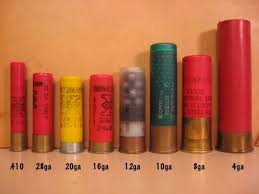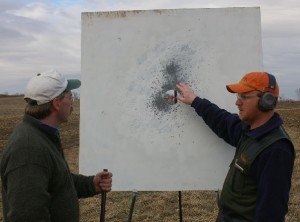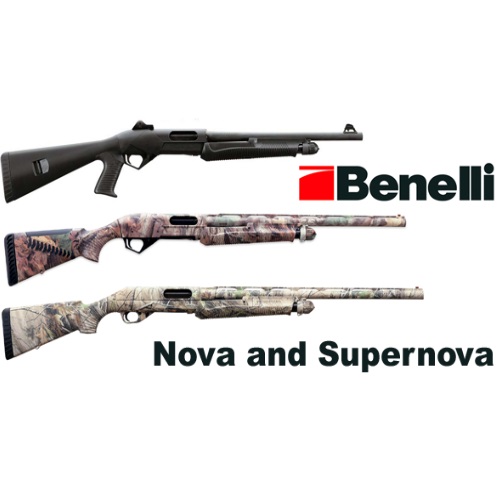Table of Contents

My wife and I both have handguns for home defense, and concealed carry personal defense. We also both love the outdoors and using our skills to hunt our own dinner. She loves coming with me and acting as a spotter when I go shotgun hunting. Handling my 12-gauge Mossberg 500 has never been pleasant for her which is why she tends to have me handle the shooting. We make a great spotter/shooter team despite her wanting a more active role. We have several hunting rifles which she uses, but there is just something different about a shotgun. Maybe it feels more primal and personal, since the ranges involved are usually closer. Maybe the lack of optics makes it feel more traditional. Regardless, we decided to buy a shotgun suitable for her.
I hadn’t shot anything but a 12-guage shotgun in years, so after doing some research I narrowed it down to a .410 bore or a 20-gauge. A third option, the 28-gauge, would make an excellent shotgun for beginners of all ages and statures. The 28- gauge shotguns typically have very light recoil, pattern well, and maneuver beautifully. They are far more effective than their small bore might suggest patterning more like a 20 gauge than a .410 bore. The downsides are the general lack of availability and high cost of 28- gauge shotguns and shells due to supply and demand, and also the far fewer options of aftermarket accessories.
Anyway, this article, unlike most that I write, will not be about a specific model, rather I’ll speak broadly about the .140 bore and 20-gauge. Hopefully at the end of the article, .410 Bore VS 20 Gauge Shotguns, you’ll get a better idea of what might be best for you.
Shotgun Basics
Most of you likely know this already, but for any that don’t I’ll briefly cover some shotgun 101. A shotgun is mainly designed to fire a group or “pattern” of many small pellets called “shot.” This makes hitting a moving or flying target, especially if the target is small, more effective than a single projectile.
Because it utilizes numerous pellets instead of a single bullet, a shotgun shell is constructed differently than a good hunting rifle or pistol cartridge. In a pistol or rifle, the cartridge’s brass case contains the primer, powder, and bullet. A shotgun’s shell consists of a plastic hull that contains the primer, powder, shot wad, and an amount of shot. They can also have a slug instead of shot, but these are generally used far less and for more specific purposes which I’ll explain more about later. Much like rifle and pistol caliber size, there are a variety of shotgun bore sizes or “gauges.” Gauges of differing shell length can all be loaded with an assortment of shot sizes.
Gauge and Bore Explained

Today most firearms are grouped by calibers, but shotguns are categorized by gauges. The main difference you need to understand is that caliber refers to a dimension while gauge represents weight. This originated in the days when you would buy lead by the pound to make your own ammo. The gauge told you how many rounds you could make for the gun from 1 pound of lead. For example “20-gauge” means you can make 20 lead balls. The smaller the gauge number, the wider the barrel. The .410 on the other hand tends to be the smallest shotgun used today. It is not a gauge at all but a .410-caliber. Its name refers to its .41-inch barrel diameter.
In the past some popular shotguns included 8-gauge, 4-gauge, 24-gauge, and 32-gauge but these are all collectors’ items now. Today the more popular shotguns used include (from smallest to largest) the .410-bore, 28-gauge, 20-gauge, 16-gauge, 12-gauge, and 10-gauge. Now that we’ve covered the basics of the different types of shotguns out there let’s take a closer look at our two contenders.
.410 VS 20-Gauge Basics
.410 Bore Shotguns
The .410 is the lightest weight shotgun you’re likely to find used by most people today. It has the gentlest recoil, but because .410 shells contain less shot its patterns are thin, and it is the hardest to hit with. Most .410 guns use full choke barrels to concentrate the available shot. This creates smaller patterns which make it more effective at closer ranges. This really limits the options of this shotgun’s uses. Furthermore, if my wife goes hunting with me she won’t be able to hit much of what I am hunting with the 12-gauge.
If you are small, very sensitive to recoil, and don’t mind the limitations of using the .410 within about 25-30 yards just for small game, it is a good choice. Some .410’s are available in lightweight Youth Models, with reduced length stocks for such shooters, who may quickly outgrow a .410.
Although reasonably popular, the .410 shotgun is usually either used by beginners or shooters with a lot of .410 experience.
20-Gauge Shotguns
The 20-gauge seems to be the best compromise. While .410 shotguns are quite useful for very young or really small shooters, most adults, regardless of size, should have no problem handling a 20-gauge especially if low recoil ammunition is used. The 20-gauge offers a significant step over the .410 in terms of usefulness and power (which I’ll get into more below). In general the .410 and is a better choice for most purposes unless an extremely lightweight firearm with slightly less recoil is an absolute necessity. My 12-gauge is also more powerful than a 20-gauge, but the difference is not so great. Many experts say that a 20-gauge shotgun is a better beginner’s gun because it also has relatively gentle recoil but fires more shot per shell than the smaller-diameter .410-caliber. When compared to my 12-gauge, the 20-gauge delivers 75% of the lead with a recoil that is 40-50% less. This is still plenty effective and the reduced recoil of the 20-gauge means you are able to more accurately and rapidly hit your target for multiple shots or hit multiple targets.
Shells and Power
The more expensive .410 shells are widely distributed and are available in 2 1/2 inch and 3 inch lengths with a reasonable selection of shot sizes and loads from bird-shot to slugs.
At relatively low cost, similar to a 12-gauge, 20-gauge shells are widely distributed and available in 2 3/4 inches or 3 inches in length. There are also a wide variety of shot shells available for the 20-gauge.
As far as “power,” both the 20 and 12 gauge shot guns have the same 1200 feet p/sec velocity ( For a look at a truly unique 12 gauge shotgun check out our Kel Tec KSG review). However, the .410 has proportionally less powder and carries 1/2 oz. of shot and the larger 20-gauge carries 7/8 oz. of shot. Shotgun ammunition manufacturers use what is called “dram equivalents” to indicate how much power the load has. The higher the dram equivalent number, the more energy the ammunition has and the faster the shot will travel. I’ll explain below how this affects pattern, and by extension the uses of these shotguns.
Shot Pattern

My wife and I took a trip down to the range. She chose from several different models of .410 and 20-gauge to try out. Unlike other gauges, which are patterned at 40 yards, .410s are generally patterned at 25 yards. Since her desire was to shoot at similar distances to me on hunting trips, but with a more manageable shotgun, we set 30 yards as a compromise distance. After a few practice runs, she settled on the single-barreled break-action model. On average, the full choke .410 shot about 88 percent patterns at 30 yards, while the 20-gauge shot around 85 percent. The higher pellet count and larger powder load of the 20 combined to put more pellets in the 30-inch circle than the .410. Penetration was unsurprisingly better too-3.4 inches vs. 3.1 inches.
At shorter ranges, the .410 had tighter patterns but the 20 consistently had deeper penetration. Since there are fewer pellets in the .410, the pattern was really wide well beyond 30 yards, meaning it can easily miss targets entirely. At 20 yards the 46-inch-long shot string of the 20-gauge was a full 20 inches shorter than the .410’s shot string. The choke on the .410 barrel leaves the pattern, no matter shot-size or load, strung out as it speeds toward a target. Hitting a flying pigeon or quail is tricky because crossing targets must pass through a thin portion of this strung-out pattern to hopefully catch a few pellets. That is why .410s will often wound, but not kill, a small animal at distances further than 30 yards. On the flip side, that long shot column makes the.410 deadly when used on nearby stationary targets. At close range these targets receive the full load.
Recoil
In general, the smaller the barrel diameter, the less “kick” or recoil the shooter feels from the gun, though this is also affected by the shell load. You can have a larger gauge with a less powerful load, and a smaller gauge with a more powerful load. Despite being a lighter weapon, the .410 does have less of a recoil generally due to low dram loads. The 20-gauge however, really isn’t terrible and tends to be easier for people to get used to especially if a rubber recoil pad is added.
Price

The shotguns themselves don’t differ so much in price. You can find the different types of shotguns in a range of price brackets. The shells of the .410 however, tend to be more expensive, and in the long run, will tend to be your greatest expense when investing in the shot gun you get.
Uses
.410 shotguns are light-weight and good for hunting squirrels, small birds. More skilled shooters will use them for shooting clay targets. The .410 is great for younger kids learning how to use a shotgun, or smaller adults. However, while they tend to be easier to use, they are not very effective as a home-defense or personal-defense weapon.
20-gauge shotguns are more versatile and effective for larger game, and with its better stopping power, home and personal-defense. Personally I still prefer my Glock 17 carry gun for this in most situations. The 20-guage is just as good for beginners, unless the child or more sensitive adults cannot actually handle it.
.410 VS 20-Gauge – Pros And Cons
.410 Bore Pros–
- Light-weight and easy to handle.
- Ammo is lighter as well; less carry weight is always a bonus.
- Gentler recoil than the 20.
- Less destructive at shorter range on small game than 20 gauge.
.410 Bore Cons–
- Tighter choke makes it more difficult to master for moving targets.
Less power and range effectiveness for things larger than nearby small game.
Ol’ Reliable - Less ammo selection, especially in the area of slugs and buckshot.
- Expensive ammo.
- Most kids out-grow the weapon pretty quickly.
20 Gauge Pros–
- A real multi-purpose shotgun, maneuverable even with added weight.
- More versatile loads available, due to the fact that the 20-gauge is a lot more common that .410 shotguns.
- More powder and pellets means it is easier to hit moving targets further away.
- A child won’t out-grow this weapon as fast (if at all).

20-Gauge Cons–
- Added weight and still has slightly more recoil than a .410.
- Ammo is heavier than a .410, which means even more carry weight.
Summing Up
The .410 did have great patterns at 20 yards. However, the .410’s shot string, which was almost 50 percent longer than that of the 20-gauge, revealed a major physics shortcoming: The longer the string, the slower the trailing pellets are traveling, and the less energy they retain. The .410 not only puts fewer pellets on target than the 20-gauge, but the .410’s tail-end pellets won’t hit as hard and penetration will suffer. The 410 is more of a specialized weapon, best suited as a squirrel gun for a young child or for adults who want the challenge of shooting a shotgun with the .410s limitations. As a serious hunting gun, unless you are an exceptionally skilled shooter it just doesn’t cut it. Also the types of ammo, price, and availability for the 20-gauge make it, despite the heavier weight, more desirable than the .410.
20-gauge shotguns are the perfect balance especially with easily available recoil pads. While the .410 may theoretically sound great , your average shooter can’t actually use it to hit anything besides an easy stationary nearby target. Unless these are your only targets, you want the shooter to be able to actually hit what they are hunting, and that is a lot easier with a 20-gauge. Higher success rates mean more enjoyment while shooting and a greater chance that shooters will continue to want to shoot and become more proficient. With the 20-gauge my wife will be able to keep up with me on any hunt from rabbits and turkeys to geese and deer.
My wife and I are currently picking out which models we to want to buy, but we know it’ll be in 20-gauge. The .410 bore isn’t bad, but it just isn’t such a great fit for her either. No matter which you eventually choose, remember that practice and experience is what will allow you to best utilize and wield your weapon. Best of luck and good hunting!




Can anyone tell me a good 20 gauge model that I should be looking for?
My wife and I have been discussing the possibility of her also getting a shotgun. After reading your review we have decided that a 20 gauge will be more practical. Now does anyone have a best manufacturer suggestion?
This may sound nuts but I am deciding on a home defense weapon. It is between the 20 and 410. I was going with the 410 as I will not be using it outside and as I also do not want to kill even an intruder I am more apt to use and pull the trigger on a 410 than a 20. I would prefer to scare them off and give them a small incentive to mend the error of their ways rather than kill them
Googy ?
Thanks you soo much for this! I’m a 4’11” chica, just getting into hunting. I was almost going to settle for .410 until I read this. Very informative, and I think a 20 gauge will be perfect, since my boyfriend will have his 12 gauge.
I’ve seen hunters using a 410 that wouldn’t reach a squirrel at the top of a tree. I like the 20 gauge Winchester Heavy Game load with 1 oz of #6. They have much better range and don’t tear up the meat too bad. Most of the shot goes clean through. I like #4 and #5 shot too, but, those are hard to find.
I shoot a 20 Gauge Savage pump with a full choke.
Thank you for all the information, I was undecided between the 2 but now I’m definitely going with the 20 gauge for home defense.
I recently purchaced a IfC top end for ar15 chambered in. 410. 3″ chamber, and being semi-auto/gas operatoed, recoil is almost nonexistent ttps://photos.app.goo.gl/UE1uNmiP34UYUA59A
Thank you! We really appreciate the feedback and your kind words.
Thank you for the well written and very informative article!!!